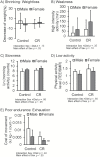Caloric Restriction and Healthy Life Span: Frail Phenotype of Nonhuman Primates in the Wisconsin National Primate Research Center Caloric Restriction Study
- PMID: 28398464
- PMCID: PMC5861888
- DOI: 10.1093/gerona/glx059
Caloric Restriction and Healthy Life Span: Frail Phenotype of Nonhuman Primates in the Wisconsin National Primate Research Center Caloric Restriction Study
Abstract
Calorie restriction without malnutrition increases longevity and delays the onset of age-associated disorders in multiple species. Recently, greater emphasis has been placed on healthy life span and preventing frailty than on longevity. Here, we show the beneficial effect of long-term calorie restriction on frailty in later life in a nonhuman primate. Frail phenotypes were evaluated using metabolic and physical activity data and defined using the Fried index. Shrinking was defined as unintentional weight loss of greater than 5% of body weight. Weakness was indicated by decline in high intensity spontaneous physical activity. Poor endurance or exhaustion was indicated by a reduction in energy efficiency of movements. Slowness was indicated by physical activity counts in the morning. Low physical activity level was measured by total energy expenditure using doubly labeled water divided by sleeping metabolic rate. Weakness, poor endurance, slowness, and low physical activity level were significantly higher in control compared with calorie restriction (p < .05) as was total incidence of frailty (p < .001). In conclusion, we established a novel set of measurable criteria of frailty in nonhuman primates, and using these criteria, showed that calorie restriction reduces the incidence of frailty and increases healthy life span in nonhuman primates.
Figures



References
-
- Yamada M, Arai H. Predictive value of frailty scores for healthy life expectancy in community-dwelling older Japanese adults. J Am Med Dir Assoc. 2015;16:1002.e7–1002.11. doi:10.1016/j.jamda.2015.08.001 - PubMed
-
- Global Health and Aging. National Institute on Aging, National Institutes of Health; 2011. NIH Publication no. 11-7737.
-
- World Report on Ageing and Health. Luxemborg: World Health Organization. www.who.int. Published 2015.
Publication types
MeSH terms
Grants and funding
LinkOut - more resources
Full Text Sources
Other Literature Sources
Medical

